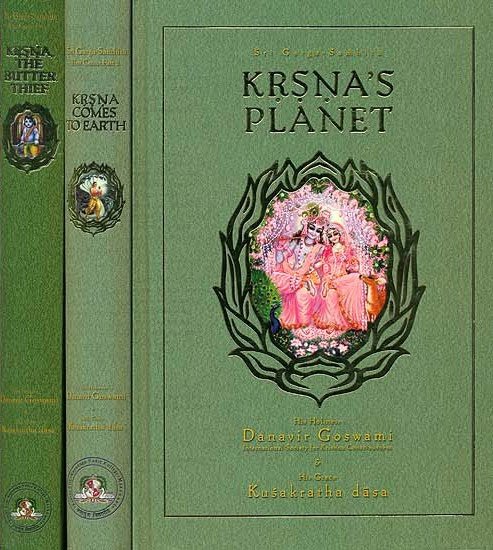Garga Samhita (English)
by Danavir Goswami | 425,489 words
The Garga-samhita Verse 3.2.11, English translation, including word-by-word: This text represents a Vaishnava scripture which narrates the life Krishna, It was composed in seventeen cantos by Garga Muni: an ancient sage and priest of the Yadu dynasty having. This is verse 3 of Chapter 2 (The Great Festival of Shri Giriraja) of Canto 3 (giriraja-khanda).
Verse 3.2.11
Sanskrit text, transliteration and word-by-word meaning:
तथाप्सरः-सर्व-फणीन्द्र-जानाम्
आसां च यूथ-व्रज-वासिनीनाम्
समाययुः श्री-गिरिराज-पार्श्वं
स्व्-अलङ्कृताः पाणि-बलि-प्रदीपाः
tathāpsaraḥ-sarva-phaṇīndra-jānām
āsāṃ ca yūtha-vraja-vāsinīnām
samāyayuḥ śrī-girirāja-pārśvaṃ
sv-alaṅkṛtāḥ pāṇi-bali-pradīpāḥ
tathā—so; apsaraḥ—apsarās; sarva-phanīndra-jānām—all the daughters of then king of serpents; āsām—of them; ca—and; yūtha—groups; vraja—of Vraja; vāsinīnām—of the residents; samāyayuḥ—came; śrī-girirāja-pārśvam—to the side of Govardhana Hill; sv-alaṅkṛtāḥ—nicely decorated; pāṇi—hands; bali—with offerings; pradīpāḥ—splendid.
English translation of verse 3.2.11:
. . . the apsarās, and all the serpent king's daughters. Now, as girls of Vraja, nicely decorated, and their hands splendid with many offerings, they approached Govardhana Hill.
